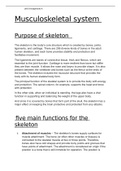Other
Unit 8 Muscular skeletal system and disorders assignment A
- Institution
- PEARSON (PEARSON)
This is the whole collection of unit 8 assignment A, B, and C. All of these received a distinction, meaning that I received a distinction overall for Unit 8 and they are well written and well detailed. Assignment A has 51 pages and 8858 words Assignment B has 36 pages and 6278 words Assignment ...
[Show more]



